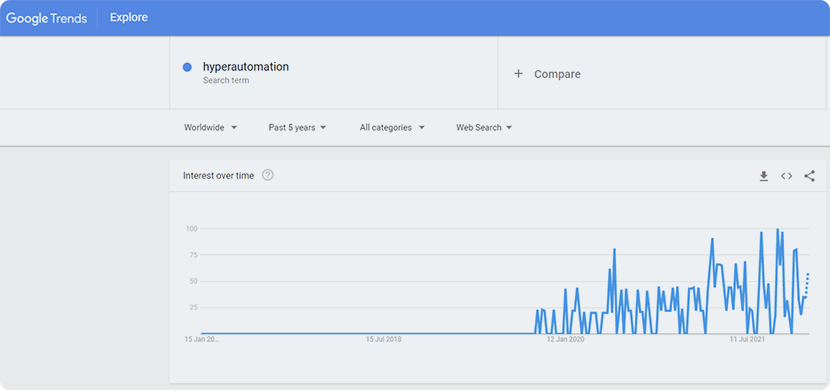

The pandemic has seen enterprises find newer ways of ensuring business continuity. Automation of tasks has been at the forefront of achieving organizational Digital Transformation at scale. Automation is now Intelligent and is a confluence of RPA, ML, AI & more. Hyperautomation is the next frontier of enterprise growth that unlocks immense gains in innovation, agility, resilience and customer-centric operations. Read on to know how Hyperautomation can be a cornerstone of an enterprise’s competitive advantage.
This article is the first of a three-part series introducing enterprise leaders to Hyperautomation. The following two pieces will address how you can evaluate your enterprise’s readiness to take on the Hyperautomation journey and how successful implementations can help you drive exceptional customer experience at lower costs.
The last two years of the pandemic have seen enterprise leaders weather the mammoth challenge of ensuring business continuity while driving growth. Technology-enabled transformations resulting in the Automation of tasks have been at the forefront of their response. Automation was first implemented to bring efficiencies to repetitive processes executed through rules-based decision-making. With the advancement in technology, Automation soon expanded its horizons to become Intelligent Automation by drawing on technologies at the confluence of RPA, ML, AI, computer vision, and NLP. Intelligent Automation enables enterprises to push the boundaries of Automation with higher accuracy, cost, and efficiency, making it critical to this technology-enabled transformational change to automation journey. With the value of Intelligent Automation firmly established, organizations are now set to unlock the next frontier of enterprise growth – Hyperautomation.

Interpreting Hyperautomation Journey
In 2019, Gartner listed Hyperautomation as a top strategic technology trend for 2020. According to Gartner, “Hyperautomation deals with the application of advanced technologies, including artificial intelligence (AI) and machine learning (ML) to increasingly automate processes and to augment humans.”
EdgeVerve published a white paper introducing a concept for a vision that would drastically transform enterprise operations by creating a customer-centric workforce driven by a human-digital twin. We called this vision Automation Singularity.
“Automation Singularity is a highly customer-centric and agile-oriented state of constant improvement and optimization through the future workforce, opening up an expanded horizon of possibilities. Human specialists drive customer orientation using their creativity and empathy and are complemented by digital workers with extreme productivity and consistency. Automation Singularity serves as a beacon for enterprises to conceive, design, structure, and deliver products and services. The idea of Automation Singularity is a journey where a variety of automations (including attended and unattended Automation) along with AI capabilities will unleash unprecedented value, touching every process, every employee, and every system in the enterprise.” – EdgeVerve White Paper on Automation Singularity.
Envisioning a state of Automation Singularity is the first step on the Hyperautomation journey.

Why Hyperautomation is the Next Frontier
To keep up with the demands of accelerated digital transformation cycles, the rapid and virtually seamless transition to remote work, competition from disparate segments, and evolving customer needs, enterprises must have a laser focus on making Hyperautomation a cornerstone of their competitive advantage.
As we enter the third decade of the 21st century, it is evident that Digital Transformation is not a linear journey. Black Swan events like the pandemic alter the course of our evolution dramatically, and this change is most apparent in technology adoption. Resource shortage during the pandemic led enterprises to evolve their ways to accelerate the Automation of the tasks completed by human agents. Therefore, adaptability is and will continue to be critical as enterprises move from a survival mindset to one of thriving. A look at Google Trends data for the interest in Hyperautomation points to a clear spike in the idea’s popularity, specifically its relevance to enterprise transformation.

Fig:Search volumes for Hyperautomation have been on an upward trend since 2019 and continue to spike.
Note:This graph shows the interest in Hyperautomation over time. Numbers represent search interest relative to the highest point on the chart for the given region and time. A value of 100 is the peak popularity for the term. A value of 50 means that the term is half as popular. A score of 0 means there was not enough data for this term.
As this McKinsey report, aptly titled “The Recovery Will be Digital,” states, the current context needs C-suite executives to “remember it’s 99% perspiration”, urging them to obsess over improvements in tech, better customer experience, and ease of use. With its ability to drive extreme efficiency and quality at scale, Hyperautomation helps them do just that. However, to achieve benefits beyond the low-hanging fruits represented by task-based speed, enterprise leaders must center their planning on Intelligent Automation that will drive their Hyperautomation journey. Powerful platforms that provide a combination of RPA, Process Discovery, and Process Mining will enable enterprises to accelerate their progress.

The Premise and the Promise
For any enterprise, a vision for Automation Singularity will drive the destination and design of the Hyperautomation journey. Such a vision involves a holistic approach to Automation, enhances end-to-end operational decision-making, and, more importantly, moves organizations towards AI-driven decision-making, especially for complex processes.
Hyperautomation improves upon previous iterations of Automation through a suite of smart features, such as:
-
-
Cognitive Services
Cognitive Automation is the application of machine learning technologies to Automation to take over tasks that would otherwise require manual intervention to achieve results. With cognitive services, enterprises can make their workflows more efficient beyond the scope of current Automation technologies to accomplish a higher level of operational efficiency.
-
-
-
Contextual Intelligence
Contextual effectiveness drives use at scale. For any technology to have enterprise-wide adoption, it must serve a variety of uses cases and user contexts. Advances in machine learning and AI combined with the empirical data used to identify Automation candidates can create a continuously improving digital brain for organizations capable of mitigating risk, improving performance, building resilience, and accelerating innovation.
-
-
-
Smart Bot Management
Enterprises can now develop and manage their smart bots with the right platform. The ability enables the deployment of digital workers specific to an organizational context. Additionally, with low-code and no-code platforms, business users can also design automations, shattering the silos that previously restricted the scale of automation projects.
-

Implementation Imperatives of Hyperautomation
Leaders looking to build their enterprise for Hyperautomation will face a set of complex challenges. While these obstacles are dwarfed by the opportunities the solutions represent, they deserve your attention. In our experience, the most prominent of these imperatives include:
-
-
Establishing a return on investment (ROI)
The Hyperautomation journey involves end-to-end workflow Automation that touches multiple units within an enterprise. Establishing RoI and seeking executive sponsorship in such scenarios isn’t straightforward. Several Automation pilots fail to start, simply fail, or fail to scale because of a lack of understanding or ownership of comprehensive value in the early stages of implementation. Enterprises must evaluate their business context to select the best journeys for Automation before estimating and measuring the RoI. This demands strong leadership that can drive cultural change through organizational silos, supported by best-in-class platforms in the market that use a data-driven approach backed by empirical data, process intelligence, and tools to measure RoI.
-
-
-
Ensuring leadership for the entire project
While Hyperautomation affects every process and person in the enterprise, it is essential to have clear and continuing leadership capable of owning and driving the implementation process. We have found that successful Hyperautomation implementations need exceptional leadership and enhanced collaboration.
-
-
-
Comprehensive change management exercise
Hyperautomation will transform your entire organization. A transformation of this magnitude needs the development and execution of a total change management exercise to ensure buy-in and education at all levels across the organization. The narrative around the concept of Hyperautomation is rife with misinformation, and prioritizing change management and education will ensure that your entire organization is committed to the Hyperautomation journey.
-
-
-
Establishing, tracking, and managing project timelines
Digital transformation driven by Hyperautomation is a vision driven by a habit beyond a short-term implementation. Breaking every implementation into a series of well-structured and tracked projects will help enterprises enjoy greater success in their journey and support their execution teams rack up a series of small wins critical to maintaining motivation and leadership trust.
-
Loved what you read?
Get practical thought leadership articles on AI and Automation delivered to your inbox
Loved what you read?
Get practical thought leadership articles on AI and Automation delivered to your inbox
We are fortunate to be living in an age of endless possibilities supported by technological progress and innovation. Hyperautomation represents the very best that this evolution has to offer in the enterprise space. More importantly, it provides solutions tailored to an enterprise’s specific context instead of a cookie-cutter approach to efficiency. Now that you understand the value and potential impact of Hyperautomation, the next step would be to develop an intrinsic understanding of your organization’s context to create a plan in line with your specific needs and challenges. The next article in this three-part series will guide you through a step-by-step process of understanding your enterprise’s readiness for Hyperautomation and maturity in its transformation journey.
EdgeVerve AssistEdge is an Intelligent Automation platform designed to supercharge your enterprise’s Hyperautomation journey. As a cohesive Automation platform with enterprise-grade capabilities, it combines the best that Intelligent Automation has to offer with EdgeVerve’s extensive and proven track record in consulting, offering you powerful support. Please click here to learn more about the platform and request a demo with an expert.
Disclaimer Any opinions, findings, and conclusions or recommendations expressed in this material are those of the author(s) and do not necessarily reflect the views of the respective institutions or funding agencies







